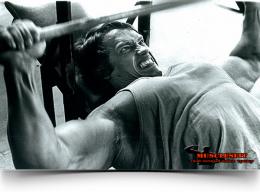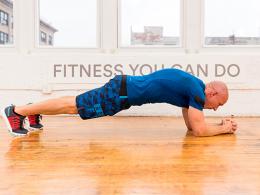How to quickly learn to pull up on the horizontal bar from scratch with the help of special exercises
Pull-ups are an excellent exercise to build strong upper body muscles: lats, rhomboids, biceps, abs, and pecs. However, it takes time to learn how to pull up. If you want to master pull-ups, start with the simplest movements for beginners. Gradually return to normal movements.
In this article, you will learn how to learn how to pull up on the horizontal bar from scratch, performing auxiliary exercises for beginners, you can reach 20-30 and even more from once. It all depends on your desire and regularity of training. Pay close attention to the state of your body and try not to overdo it.
Now let's figure out what exercises you need to do in order to learn how to pull yourself up, even if you can't do it even once. When you learn to do at least one repetition on the bar, you will begin to engage in a special training program for beginners and, as a result, you will be able to do 10-20 pull-ups on the horizontal bar.
1. Hanging on bent arms
To strengthen the muscles of the shoulder girdle and arms, learn how to pull up without jerking, start by hanging on bent arms. To perform it, climb onto the bar from the stand, it should be so high that your chin is above the horizontal bar. Grasp it so that the palms are turned towards you. Pull yourself up and hold the hang slightly above the bar. Stay in this position for as long as you can. As you progress to the pull-ups, gradually increase the hanging time. This is the first step to pull-ups from scratch.
2. Dead hang
Dead hanging develops arm strength and allows you to gradually strengthen them in order to move on to pull-ups. To perform it, climb onto the crossbar from the stand, it should be of such a height that you can barely reach the horizontal bar. Grasp it so that the palms are turned away from you. Pull yourself up a couple of centimeters, spreading your elbows to the sides. Bend your knees to come off the stand, hang and hold this position for as long as you can.
- During this exercise, the shoulders should not rise. If you feel like your shoulders are pulling up, you need to build up more strength before moving on to real pull-ups. To engage in the horizontal bar, in order to quickly learn how to pull up and do it easily, you will have to work hard. But this technique works great!
3. Slow lowering of the body
Lowering the body down also takes practice. To take a position from which you will go down, place a stand under the crossbar, grasp with your hands about shoulder width apart, palms facing you. Tighten your muscles and get off the stand. Go down very slowly. Then go back to the stand and repeat the process.
- This exercise should be done every time until you can lower yourself slowly. You must be able to control the speed of the movement of the body. This is necessary in order to train the muscles and increase the number of pull-ups in the future. If you fall down from the top position, you are not yet ready for pull-ups.
4. Develop a schedule for pull-ups
| Approach/day | Monday | Wednesday | Friday | Sunday | Tuesday | Thursday | Saturday |
| Approach #1 | 1-2 | 3 | 4 | 3 | 5 | 6 | 2 |
| Approach #2 | 2-3 | 4 | 3×2 | 4 | 3x3 | 4 | 4 |
| Approach #3 | To failure (3+) | 2×2 | To failure (5+) | 2×3 | To failure (7+) | 3x3 | To failure (10+) |
You should have a rep scheme and a training program. Each workout, work on one aspect as you move towards real pull-ups. Set a schedule and alternate different techniques, between classes do not forget to arrange rest days so that you can do well later.
- Start with a hang. Do approaches for about 20 to 30 seconds with breaks between them for one to two minutes. Do these workouts every other day to strengthen your muscles - this is an important physical preparation for learning to pull up.
- Then proceed to lower the body. Try to do eight repetitions of the movement. Perform two or three sets, resting between them for about a minute. Do this exercise through training, it's a good system.
- As you get comfortable with the pull-ups, begin to combine hanging and lowering the body, do not forget to rest between sets. Gradually, you will find that it is not difficult for you to raise your body and move on to pull-ups, which can be done even at home.
Part 2: Transition to normal pull-ups
1. Start with hanging and chin-ups
Before moving on to full-fledged pull-ups, work on a combination of hanging and pull-ups. Start with three to five repetitions of 20-30 seconds, during which you just hang on the horizontal bar. Then stand on the stand and take out the body so that the chin is above the crossbar. Bend your knees, keeping your torso in the top position. Do three to five repetitions of this exercise, holding the position for five to 10 seconds each.
- Practice this exercise through your workout until you are completely comfortable with it, then increase the number of pull-ups.
2. Do Negative Pullups
Negative pull-ups help the body get used to the phase when it comes down - anyone who knows how to pull up will attest to this. To perform them, repeat the exercises with a stand where the body goes down. Then pull up just a little bit. Raise your body as far as you can without jerking. Do six of these reps.
- When you master the negative version of pull-ups, you can move on.
3. Transition to Australian deadlift
To perform the Australian deadlift, find or set up a bar at about waist height and hang from it. Grab your hands slightly wider than your shoulders. The pose should look like an inverted lying position. Straighten your arms and stretch your legs forward. Then pull your chest up to the bar. Hold the position for three seconds. Perform 8 pull-ups.
- Once you've mastered three sets of 15 reps of this type of pull, you can move on to normal full pull-ups.
4. Start doing pull-ups
After gradually building up your skills, you should be able to perform pull-ups. Grasp the bar and hang on the horizontal bar, palms should look away from you. Perform a pull-up. Keep pulling until your chin is above the bar, pause at the top, then lower.
5. Gradually increase the number of pull-ups
You will most likely only be able to do a few pull-ups per workout at first. Do not try to do too much at once, as you risk overworking. Try to add no more than one or two pull-ups per set each time, but gradually you need to bring their number to at least 10.
Part 3: Precautions
1. Check with your doctor before starting a new workout plan.
You should never break into new movements before you talk to a specialist. This is especially important if you have any medical conditions. Before you try to do pull-ups, make sure that this type of load is safe for you.
- Talk to your doctor about any problems or precautions you may have regarding your back, neck, shoulders, elbows, or hands.
2. Avoid jumping
If you're new to pull-ups, you'll want to jump up and down to help throw your body up. However, this does not allow you to use the muscles necessary for proper pulling up. Try to lift the body only with the strength of the arms and upper body. No need to jump on the crossbar.
3. Beginner pull-up training program

Any weight training, not just pull-ups, should be done no more than a few times a week. Exceeding this figure is fraught with overtraining. Always set aside a day to rest between workouts.
Main conclusions
To learn how to pull up on the bar from scratch, even if you can’t pull up even once, start doing some simple exercises, such as hanging on the bar, pulling up from the stand or helping a partner, try to hang on the bar for as long as you can. Before moving on to normal pull-ups, start with the negatives, and work your way up with the support. Then slowly lower your body down, controlling the movement as much as possible to pump up the muscles of the hands. Once they are strong enough to complete at least one pull-up, gradually add more and more reps to your workout.






